"For some years, I have been afflicted with the belief that
flight is possible to man. My disease has increased in severity and I feel that it will
soon cost me an increased amount of money, if not my life…."
Wilbur Wright |
Barely
3-1/2 years after Wilbur Wright penned those words to Octave Chanute, the Wright Brothers'
1903 "Flyer" lifted from the sands at Kitty Hawk North Carolina to make the
world's first powered flight. With Orville at the controls, the plane flew 120 feet (37
meters) in 12 seconds. The Brothers made three more flights that day. The longest, by
Wilbur, was 852 feet (260 meters) in 59 seconds.
When the Wright Brothers arrived at Kitty Hawk in
1903 for their historic attempt, they were almost certain of success. They had all but
conquered the air the previous year with over 1,000 successful gliding flights in their
1902 glider, "all under perfect control of the operator," wrote Wilbur.
But only one year prior to their 1902 success, after disappointing glider experiments in
1900 and 1901, the Brothers had nearly given up in defeat. They had based their wing
designs on the work of predecessors, pioneers who were widely respected within the
scientific community, only to discover that all of it was hopelessly in error. On
returning from Kitty Hawk after unsuccessful gliding experiments in 1901, Wilbur's despair
was evident when he declared: "Not within a thousand years will man ever
fly." But in one last effort, the Wrights turned to wind tunnel tests and
finally uncovered the secrets of heavier-than-air flight. An elated Orville wrote to a
friend: "Isn't it astonishing that all of these secrets have been preserved for
so many years just so we could discover them!" The 1902 glider would prove out
their new discoveries, and the 1903 machine, essentially a larger powered version of their
1902 glider, would take to the air in triumph.
Today, Orville and Wilbur Wright are widely
acknowledged for their enormous technical achievement in developing the world's first
successful airplane. The Wright Brothers not only developed the first accurate theories on
the design of wings and propellers, they also designed and built their own engine, and
they invented the three-axis control system, which is still used on airplanes today.
The personal dimension of the Wright Brothers'
conquest is equally as impressive as their technical achievement. Neither Orville nor
Wilbur had graduated from High School. They had no formal training in the scientific
theories and methodologies considered essential to designing a successful flying machine,
so their chance of success was remote. As a result, they received no financial support.
Their experiments had to be supported entirely with their own money. In contrast, Samuel
Pierpont Langley, Director of the Smithsonian Institute at the time, received a $50,000
grant from the U.S. Government to build a flying machine, which ultimately failed to fly.
So it was entirely unreasonable for the Wright Brothers to believe they could succeed
where highly trained engineers and scientists with large financial resources had failed.
Not only did they conquer the air, they also conquered a world of skeptics and their own
personal self-doubts. They accomplished what they should not have been able to accomplish.
On the 100-year anniversary of the Wright
Brothers' conquest of the air, I offer this personal tribute to their achievement, and
acknowledge the same spirit of adventure and achievement that lies within each of us.
Robert Q. Riley
The Grand Adventure
"If you are looking for perfect safety, you will do well to
sit on a fence and watch the birds…"
Wilbur Wright |
Since the beginning of
history, humans have dreamed of the ability to soar on wings with the freedom of birds.
But folklore is replete with admonishments against dreaming too large. Icarus of Greek
mythology fashioned wings of wax and feathers, then flew too close to the sun. The wax
melted and the feathers came loose, and Icarus plunged to his death in the sea. He had
dared to go beyond his place in life and was properly smitten for his audacity.
The Wrights were aware of the very real hazards of
venturing into the unknown domain of the air. Speaking at a meeting of the Western Society
of Engineers in Chicago in 1901, Wilbur alluded to the risk with a statement that seems to
apply equally to life itself: "If you are looking for perfect safety, you will do
well to sit on a fence and watch the birds; but if you really wish to learn, you must
mount a machine and become acquainted with its tricks by actual trial."
The Wright Brothers were unwilling to sit on a fence and
watch the birds. They had chosen a grand adventure over the safety of the fence.
Genesis of a New World
The Wright Brothers interest in flying began when, as
young boys, their father brought home a toy Penaud helicopter. The toy sparked a fascination with flight that would
ultimately change the world. Their pursuit of flying did not begin in earnest, however,
until 1899 when Wilbur Wright wrote to the Smithsonian Institute requesting "…all
that is already known" about flying. Based on what they learned from prior work,
the Wright Brothers concluded that the correct way to design wings was already known, and
only a system of controlling a machine in the air was still missing. Previous
experimenters had been so focused on simply getting off the ground that they had largely
ignored the
home a toy Penaud helicopter. The toy sparked a fascination with flight that would
ultimately change the world. Their pursuit of flying did not begin in earnest, however,
until 1899 when Wilbur Wright wrote to the Smithsonian Institute requesting "…all
that is already known" about flying. Based on what they learned from prior work,
the Wright Brothers concluded that the correct way to design wings was already known, and
only a system of controlling a machine in the air was still missing. Previous
experimenters had been so focused on simply getting off the ground that they had largely
ignored the
 problem
of how to control a machine once it was in the air. This shortfall led to Otto
Lilienthal's fate, a German glider pilot who plunged out of control to his death in 1896.
A gust had upset the glider, and simply shifting his body weight, as was the practice with
early gliders, was not enough to bring the machine back to level flight. A system of
control, the Wrights believed, would be their contribution to mankind's quest for the air. problem
of how to control a machine once it was in the air. This shortfall led to Otto
Lilienthal's fate, a German glider pilot who plunged out of control to his death in 1896.
A gust had upset the glider, and simply shifting his body weight, as was the practice with
early gliders, was not enough to bring the machine back to level flight. A system of
control, the Wrights believed, would be their contribution to mankind's quest for the air.
The Wright Brothers invented a method of twisting the
wings so one wing angled upward and the opposite wing angled downward. This, they
reasoned, would enable them to level out the wings after being rolled to one side by a
gust of wind. They built a small kite to test the system and found they could perfectly
control the kite by pulling wires that were rigged to actuate the "wing warping"
mechanism. Their next step was to test it on a full-size glider capable of carrying a
pilot.
First Steps - 1900 Glider Experiments
In 1900, the Wrights built the first in a series of
full-size gliders to test their wing warping theories. They used Otto Lilienthal's tables
of lift to determine the curvature of the wings. Previous experimenters had discovered
that an airplane wing must be curved on top in order to produce lift. And Lilienthal's
tables of lift were considered the most accurate guide in defining precisely what shape a
wing should have and the amount of lift it would produce. The Brothers followed
Lilienthal's tables almost to the letter, making only a slight change so they could get
more lift at lower speeds.
 They planned to test the glider as a
kite, and then to spend many hours gliding on the winds at Kitty Hawk while tethered to a
post. This, they reasoned, would give them the gliding time necessary to learn the tricks
of the air. In a letter to Octave Chanute, Wilbur offered his thoughts about the
importance of skill to human flight: It is possible to fly without motors, but not
without knowledge and skill. This I conceive to be fortunate, for man, by reason of his
greater intellect, can more reasonably hope to equal birds in knowledge, than to equal
nature in the perfection of her machinery. They planned to test the glider as a
kite, and then to spend many hours gliding on the winds at Kitty Hawk while tethered to a
post. This, they reasoned, would give them the gliding time necessary to learn the tricks
of the air. In a letter to Octave Chanute, Wilbur offered his thoughts about the
importance of skill to human flight: It is possible to fly without motors, but not
without knowledge and skill. This I conceive to be fortunate, for man, by reason of his
greater intellect, can more reasonably hope to equal birds in knowledge, than to equal
nature in the perfection of her machinery.
Unfortunately, the Wright Brothers would not gain the skill
they had envisioned. The glider performed well as a kite, and their wing warping system
worked. But the glider's lifting power fell far short of predictions made by Lilienthal's
tables. The glider could lift a pilot only in very strong winds, which made it difficult
to control and dangerous to fly. So the Wright Brothers returned to Dayton determined to
build an improved glider and go back to Kitty Hawk the following year.
Failed Improvements - 1901 Glider Experiments
Suspecting the change they made to Lilienthal's wing
curvature may have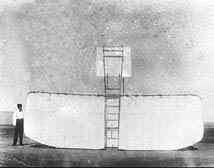 contributed to the shortfall of lift in 1900, the Brothers
precisely followed his curvature on the 1901 machine. For greater lift, they increased the
size of the wings. The Wright Brothers returned to Kitty Hawk in 1901 with their new
machine expecting to gain the flying experience they had missed the year before. Instead
of performing better, however, the new glider performed worse than the 1900 glider. Lift
was only slightly improved, and the machine was almost impossible to control in the air. contributed to the shortfall of lift in 1900, the Brothers
precisely followed his curvature on the 1901 machine. For greater lift, they increased the
size of the wings. The Wright Brothers returned to Kitty Hawk in 1901 with their new
machine expecting to gain the flying experience they had missed the year before. Instead
of performing better, however, the new glider performed worse than the 1900 glider. Lift
was only slightly improved, and the machine was almost impossible to control in the air.
To help with pitch instability, the Brothers made
changes that forced the wings into a curvature more like the one they used in 1900. This
restored the machine's "fore-to-aft balance," but roll control remained
difficult and unpredictable. For no apparent reason, warping the wings to lift a low wing
would sometimes work perfectly, and at
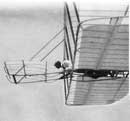 other times it would cause the low wing to actually drop farther, which
resulted in the glider spiraling into the ground. Unknowingly, the Wrights were
experiencing the world's first airplane "spins," and did not know what to make
of it. Notice the absence of a vertical stabilizer (rudder) on both the 1900 and 1901
gliders. Without a vertical stabilizer, even a modern aircraft can spin out of control
during a turn. other times it would cause the low wing to actually drop farther, which
resulted in the glider spiraling into the ground. Unknowingly, the Wrights were
experiencing the world's first airplane "spins," and did not know what to make
of it. Notice the absence of a vertical stabilizer (rudder) on both the 1900 and 1901
gliders. Without a vertical stabilizer, even a modern aircraft can spin out of control
during a turn.
After several weeks, the Wrights closed up their campsite
and headed back to Dayton in discouragement. They now realized that previous work on
aerodynamics was totally wrong, and all of it had to be discarded. Anyone hoping for
success would have to start from scratch. And with limited funds and a bicycle business
that was already suffering from their long absences while flying at Kitty Hawk, the
Brothers doubted it would be them.
Wind Tunnel Discoveries - A Roadmap to Success
After returning to Dayton, Wilbur made several discouraging
statements about the prospects of human flight, including a declaration that all previous
experimenters had been wrong in their theories on flight. Wilbur's criticism of previous
work prompted an invitation to come to Chicago and present his findings to a group of
scientists and engineers, which Wilbur reluctantly accepted. After accepting the
invitation, however, the Brothers began to consider the scientific validations that would
be necessary if they were to be taken seriously by a professional audience, especially
since neither Orville nor Wilbur had much of a formal education. So mainly to avoid
embarrassment, the Wright Brothers set out on a series of wind tunnel tests designed to
document their theories. These tests, however, did more than just provide documentation.
They uncovered the secrets of flight!
Wind tunnel testing began in the fall of 1901 and was
concluded early in 1902. In the end, the Brothers had accumulated more information on the
design and behavior of wings than anyone else in history. They now knew how to correctly
design wings, how to predict an airplane's lifting power, how to calculate the air drag of
various shapes, and how to determine the size of the engine needed to make an airplane fly
under its own power. The Wright Brothers had all the information necessary to design a
successful flying machine.
Success at Last - The 1902 Glider
When the Wright Brothers returned to Kitty Hawk in 1902
they brought parts and
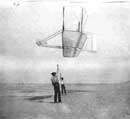 drawings
for a completely redesigned glider based on their wind tunnel discoveries. They now
understood the effect of "aspect ratio" on a wing's lifting power. Aspect ratio
is the relationship between a wing's cord (front-to-rear dimension) and its span
(tip-to-tip dimension). Long slender wings have more lift than short stubby ones. drawings
for a completely redesigned glider based on their wind tunnel discoveries. They now
understood the effect of "aspect ratio" on a wing's lifting power. Aspect ratio
is the relationship between a wing's cord (front-to-rear dimension) and its span
(tip-to-tip dimension). Long slender wings have more lift than short stubby ones.
The vertical stabilizer is another new feature of the 1902
machine. Its purpose is to prevent the "adverse yaw" caused by warping the
wings. Every aircraft naturally yaws to the outside of a turn because of the difference in
drag between the two wings during a banking turn. This difference in drag rotates the
aircraft around its vertical axis toward the wing having greater drag (the high wing).
It's call "adverse yaw" because to turn properly the aircraft should yaw into
the turn, not to the outside of it. So the correct yaw has to be provided by pivoting the
vertical stabilizer into the turn, somewhat like the rudder on a boat.
Initially, the 1902 glider was equipped with two
side-by-side vertical stabilizers that were mounted in a fixed position. But the Brothers
still experienced a control problem, which they referred to as "sidling off into the
ground." They finally hit on the idea of making the vertical mounted in a fixed position. But the Brothers
still experienced a control problem, which they referred to as "sidling off into the
ground." They finally hit on the idea of making the vertical
 stabilizer movable (like those on modern
aircraft). So the Brothers switched to a single rudder and connected it by wires to the
wing warping mechanism so it would turn in unison with the wings. This final modification
resulted in fully coordinated turns, and produced the world's first fully controllable
flying machine. The Wright Brothers had invented the three-axis control system, which is
used by every aircraft flying today. stabilizer movable (like those on modern
aircraft). So the Brothers switched to a single rudder and connected it by wires to the
wing warping mechanism so it would turn in unison with the wings. This final modification
resulted in fully coordinated turns, and produced the world's first fully controllable
flying machine. The Wright Brothers had invented the three-axis control system, which is
used by every aircraft flying today.

The Brothers made more than 1,000 gliding flights from the
sandy hills near Kitty Hawk, "all under perfect control of the operator,"
wrote Wilbur. Orville wrote to his sister Kathrine on leaving Kitty Hawk in 1902: "We
now hold all the records! Largest machine, longest distance glide, longest time in the
air, smallest angle of descent, and in the highest wind."
Triumph - The 1903 Flyer
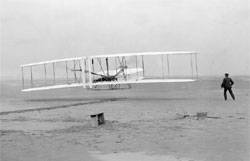
When the Wright Brothers arrived at Kitty Hawk in 1903 with
parts for their powered "Flyer", they were almost certain of success. The new machine was based on their highly
successful 1902 glider, and power requirements had been determined by equations derived
from their wind tunnel tests. So the
Brothers were confident they would succeed.
The
1903 Flyer was a large 605-pound (274kg) machine with a wingspan of 40.3 feet (12.28
meters). Except for the 7,000-pound (3175 kg)
steam-powered monster built by Hiram Maxim (inventor of the machine gun) in England in
1894, it was the largest machine anyone had ever attempted to fly. But the task of designing a powered flying
machine turned out to be far more challenging than the Brothers had envisioned at the end
of their 1902 gliding experiments.
The
Wright Brothers believed that once the problem of control was solved, all that remained
would be to add an engine and propellers, and take to the air. Gasoline engines were already being
manufactured, and propellers were widely used on powered water craft. So, the Wrights believed, they would simply order
an appropriate engine, and build propellers according to the principles used to design
boat propellers. Both of these
presumptions would soon evaporate.
The
Brothers wrote to several engine manufacturers with a request for
 an engine
weighing no more than 180 pounds and capable of producing at least 8 horsepower. No one was interested in providing such an
engine, so the Wright Brothers had to design and build their own. The four-cylinder Wright engine, built in their
Dayton bicycle shop by chief mechanic, Charles Taylor, weighed slightly less than 200
pounds and developed 12 horsepower, or about twice the power of today's lawn mower
engines. an engine
weighing no more than 180 pounds and capable of producing at least 8 horsepower. No one was interested in providing such an
engine, so the Wright Brothers had to design and build their own. The four-cylinder Wright engine, built in their
Dayton bicycle shop by chief mechanic, Charles Taylor, weighed slightly less than 200
pounds and developed 12 horsepower, or about twice the power of today's lawn mower
engines.
The
next task was to design the propellers, and for this they turned to technical literature
on boat propellers. Since air screws
(propellers) and water screws both operate in a fluid environment, they reasoned that
theories on water screws would point the way to a design for efficient air screws. To the Brothers dismay, however, they discovered
that boat propellers were designed entirely by trial and error, and no one knew how or why
they worked. No theory existed on how to
design propellers, so the Brothers had to develop their own.
The
Wrights approached the challenge by first assuming that propeller blades were, in effect,
like the wings of an aircraft. Therefore, the
theories they had developed for the behavior of wings could also be applied to the blades
of a propeller. But it wasn't quite that
simple. Wrote Orville:
"With the
machine moving forward, the air flying backward, the propeller turning sideways, and
nothing standing still, it seemed impossible to find a starting point from which to trace
the various simultaneous reactions. Contemplation of it was confusing. After long
arguments, we found ourselves in the ludicrous position of having been converted to the
other's side, with no more agreement than when the discussion began."
In
the end, their discussions forced the truth out into the open,
 leaving
the Brothers with the world's first valid theory on the design of air screws. Propellers based on the Wright theory
resulted in the first efficient propellers ever made - only about 5 percent less efficient
than modern propellers. Without these highly
efficient propellers, the 1903 Flyer would have remained hopelessly earthbound. leaving
the Brothers with the world's first valid theory on the design of air screws. Propellers based on the Wright theory
resulted in the first efficient propellers ever made - only about 5 percent less efficient
than modern propellers. Without these highly
efficient propellers, the 1903 Flyer would have remained hopelessly earthbound.
 Triumph
on the sands at Kitty Hawk in December 1903 came after three years of technical inquiry
and methodical experimentation. In just
three short years, these two untrained inventors had gained more knowledge on the
principles of flight than had been accumulated in all of human history. A pursuit that began with the idea of
contributing only a control system for flying machines ended up producing the first
accurate theories on the entire range of aerodynamic interactions necessary for flight. A shortfall in any one of these areas would
have proven fatal to their attempts. Triumph
on the sands at Kitty Hawk in December 1903 came after three years of technical inquiry
and methodical experimentation. In just
three short years, these two untrained inventors had gained more knowledge on the
principles of flight than had been accumulated in all of human history. A pursuit that began with the idea of
contributing only a control system for flying machines ended up producing the first
accurate theories on the entire range of aerodynamic interactions necessary for flight. A shortfall in any one of these areas would
have proven fatal to their attempts.
Each
taking their turn, the Brothers made four flights on the morning of December 17, 1903. The longest was by Wilbur for a distance of
852 feet (260 meters) in 59 seconds. This
world-changing event was announced in a simple telegram sent from Kitty Hawk by Orville to
his father on December 17, 1903.
| SUCCESS FOUR FLIGHTS THURSDAY MORNING ALL AGAINST
TWENTY-ONE MILE WIND [stop] STARTED FROM LEVEL WITH ENGINE POWER ALONE [stop] AVERAGE
SPEED THROUGH AIR THIRTY-ONE MILES [stop] LONGEST 57 SECONDS [stop] INFORM PRESS [stop]
HOME CHRISTMAS |
Sometime
in the 1940s, Wright biographer,
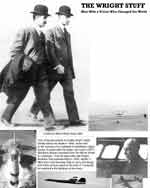 Fred C. Kelly, asked Orville: "What was the most exciting part of
inventing the flying machine? Was it when the machine took to the air for that first
flight?" Orville thought for a moment and then replied: "The most
exciting part of inventing the flying machine was lying awake in bed at night dreaming of
how exciting it would be to fly." Fred C. Kelly, asked Orville: "What was the most exciting part of
inventing the flying machine? Was it when the machine took to the air for that first
flight?" Orville thought for a moment and then replied: "The most
exciting part of inventing the flying machine was lying awake in bed at night dreaming of
how exciting it would be to fly."
Barely 66 years after the
Wright Brothers' first steps into air, Neil Armstrong and Buz Aldrin stepped onto the
surface of the moon to complete another chapter in the grand adventure. Today, only
100 years after the Flyer, spacefight is becoming routine and unmanned vehicles are
probing deep into the universe, preparing the way for manned fights to distant
worlds.
|